
|
Sale 43
Manuscript and Collectibles Auction
| Lot |
Photo |
Description |
Realized |
Lot 885 |
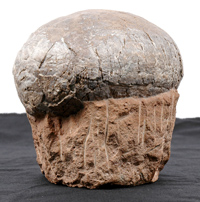 |
70 Million Year Old Museum Quality Duck-Bill Dinosaur Egg. This complete unhatched prepared Hadrosaur (Duck-bill) dinosaur egg is 70-80 million years old 6 inches long and 5 inches wide and is museum quality with nearly 100 per cent of its original shell still intact. It was found by farmers from the Xixia, Henan Province of China. The exact species of dinosaur cannot be determined from just the egg, but this shape of egg has been determined to be from a duckbill dinosaur from duckbill dino bones found in the area of these recoverd eggs. Bones from the huge Hadrosaur Shantungosaurus which reached more than 50 feet in length have been found in the same area. Fewer than one percent of dinosaur eggs are as complete and pristine as this egg. Thos exquisite egg is still positioned on a small red sandstone base of the original stone matrix. It has been airbrush to removed the stone matrix covering the shell caring a lovely dark brown color eggshell.
Add $25.00 for domestic shipping.
Estimated Value $500 - 750.
View details and enlarged photo
| Realized
$920 |
Lot 886 |
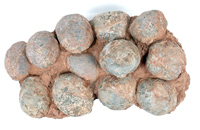 |
A Half Of A Dozen Rare Dinosaur Eggs. This approximately half nest of twelve dinosaur eggs is very distinctive in being from the rare and poorly understood class of dinosaurs known as Therizinosaurs. Therizinosaurs were some of the strangest looking dinosaurs, having some features of a plant eating dinosaur and some features of a theropod dinosaur. They had a small skull on a long neck with a large gut which resembled a plant-eating dinosaur, but also were bipedal, had filamentous feathers, and extremely large hand claws like a theropod dinosaur. Embryos have been found in some of the eggs of this shape, so we know that they belong to this strange dinosaur which probably was a plant eating dinosaur although some paleontologist think that the large claws may have been used to tear apart large termite mounds.
The twelve eggs are 3.5 x 3 inches long and still contained in their original 15 x 9 inch red limestone matrix as deposited between 80-90 million years ago in the Xixia Basin of the Henan Province, China. The eggs are in excellent condition, being unhatched and not crushed. Even though the shells of Therizinosaurs eggs is very thin, these eggs contain between of 75-90 percent of their original shell. These dinosaur eggs are in great demand and very difficult to locate.
Add $75.00 for domestic shipping.
Estimated Value $2,500 - 3,000.
View details and enlarged photo
| Realized
$2,990 |
Lot 887 |
 |
A Large Nautiloid And A Large Ammonite From Madagascar. Ammonites are the closest relative to the chambered nautilus which still exist today. This lot contains both a large 7 inch in diameter 110 million year old ammonite, Cleaniceras and a 5.75 inch long 110 million year old nautiloid from the large island of Madagascar. Both have been cut in half and polished to reveal the detail and beauty of inner chambers. Ammonites and nautiloids both started growing in the small center and added chambers spiraling outward as they grew. The living animal lived only in the last large chamber and the inner chambers were airtight and could be filled with water by the living ammonite or nautiloid to move up or down in the water.
The beautiful large 7 inch ammonite has inner chambers filled with root beer-colored calcite, middle chambers still partially open with yellow calcite crystals inside, and the last four chambers filled with a grey stone which was mud in the initial burial 110 million years ago. The 5.75 inch has a spectacular interior filled with various colors of cream to brown calcite crystal and athick sphinter tube that was used to fill the numbers with water and each chamber outlined in an orange colored mineral. It is informative to compare the differences in construction between the ammonite and the nautiloid.
Add $25.00 for domestic shipping.
Estimated Value $250 - 300.
View details and enlarged photo
| Realized
$230 |
Lot 888 |
 |
Almost Two Foot Long 130 Million Year Marine Reptile. This Sinohydrosaurus is immense at 22 inches long on a 26 x 9 inch long tuffaceous sandstone slab. Sinohydrosaurus translates to Chinese water reptile and they are 130 million years old from Liaoning Province, China. Like the famous feathered dinosaurs from this area, they too were buried in the massive volcanic eruptions that occured several times in the Liaoning area Northeastern China. This large adult Sinohydrosaurus is virtually complete with intricate delicate detail of the bones of the body, ribs, small feet and claws and particulary the skull which has both the lower and upper jaws slightly disarticulated revealing many small sharp teeth. The teeth are rarely seen even in the best of specimens. Only a few tiny toe bones and claws from the and back feet are missing. Being composed of soft volcanic ash, the stone is very soft and brittle and is nearly impossible to remove without cracking the matrix. The inevitable carcks in the large matrix of this museum quality specimen have been professionally smoothed over with gypsum to give it a nice even appearance. The Matrix has been backed as well to add extra stability. Large specimens such as this one are almost impossible to locate with most available Sinohydrosaurs being less than 10 inches long.
Add 50.00 for domestic shipping.
Estimated Value $1,500 - 2,000.
View details and enlarged photo
| Unsold |
Lot 889 |
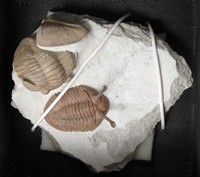 |
Bizarre Trilobite With Long Eye Stalks. Neoasaphus kowalewski was a very strange looking trilobite with extremely long eyestalks (over 1 inch) and must have looked like something from another planet as it crossed the warm ocean floor 450 million years ago in the Wolchow river near St. Petersburg, Russia. This strange trilobite would bury itself in the sand to hunt small prey animals and also protect itself from predators. This lovely complete brown trilobite is 3 inches long and is on the same 6 x 6 inch limestone matrix with another species of asaphus trilobite, but this did not have its eyes on eyestalks but it has an ornamented pattern on its tail (pygidium) which undoudtedly was several different colors when this trilobite was is also a two inch long pygidium from another trilobite that also exhibits this color pattern. This partially enrolled trilobite and tail section are a lighter beige color than the Neosaphus and make for both an esthetically pleasing as well as scientifically important specimen.
Add $25.00 for doestic shipping.
Estimated Value $600 - 700.
View details and enlarged photo
| Unsold |
Lot 890 |
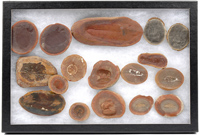 |
Collection Of Mazon Creek Fossils. Mazon Creek is famous for the wide variety of 300 million year old plants and animals that were found in the Francis Creek Shale of Illinois. Some animals with shell are present but it is the rare soft bodied fossils that make this fossil deposit so special. This collection of eleven different fossils that are representative of the types of fossils present start out with the most famous fossil to be found in Mazon Creek, that is the Tully monster. The Tully monster was a strange looking soft bodied predator that was long with small fins, two eyes on stalks and most strangely a long proboscis that ended in a claw or jaw. This is the Illinois state fossil and is found no where else on earth. The excellent specimen in this collection is 3.5 inches long and is more complete than usual, missing only the fins and the claw at the tip of the proboscis. The other interesting soft bodied and shelled fossils in this collection include two different jelly fish, a small shrimp, two different worms, two different kinds of leaves, a shell and a clam, and lastly, a very strange animal called a cyclus, which was round with antennae, unlike any other animal known. All of these fossils are above average for their type and rare. Housed in a 12 x 8 inch Riker mount.
Add $20.00 for domestic shipping.
Estimated Value $300 - 400.
View details and enlarged photo
| Unsold |
Lot 891 |
 |
Extremely Large 49.5 Ppound Campo del Cielo Iron-Nickel Meteorite With Two Natural Holes. This 49.5 pound 13 x 9 x 4 inch iron-nickel meteorite is not only the heaviest complete meteorite that we have auctioned but also esthetically the most valuable with excellent shape, regmagylpts (thumb prints) and two natural holes. Natural holes form when the softer troilite (iron sulfide) melts during the meteorites fiery entry through the atmosphere. Troilite melts at a much lower temperature than the rest of the iron-nickel meteorite. Natural holes rarely occur in larger meteorites because they are too thick to completely melt through and such meteorites are in great demand by collectors. Know as Campo de Cielo (field of the sky), these meteorites fell from the sky over 4000 years ago in Gran Chaco Gualamba, Argentina and were written about 1576 by the Spanish governor who learned about them from the local Indians who believed that the iron stones fell from the sky. A large 60 ton meteorite known as Meson de Fiero (large table of iron) was sent back by ship to Spain and melted down. The best specimens of Campos such as this one are known as new Campos as they are found hoigher up in the mountains and have not been worn down by rusting from rain water. This esthetically sculpted meteorite possesses many regmaglypts as well as the all important holes with prominently show when the meteorite is stood up on its natural base for a dramatic display. If you only want to own one meteorite this spectacular specimen is it.
Add $75.00 for domestic shipping.
Estimated Value $3,000 - 4,000.
View details and enlarged photo
| Realized
$3,335 |
Lot 892 |
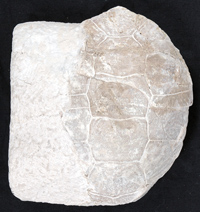 |
Fossil Badlands Turtle. Stylemys nebrascensis was a 30 million year old tortoise that roamed the White River Formation of the Badlands of South Dakota. This attractively displayed specimen measures 5.5 x 3.5 inches and is partially embedded in its original sandstone matrix set on its side. The outer carapace was formed by a series of scutes made of keratin originally. Keratin is the same material that our finger nails are made of. Most of the underside of the tortoise, the palstron, which was formed by bony plates is preserved. A small portion of one of the edges is missing but is esthetically covered up by matrix. Turtles are extremley popular and not at all common in the fossil record.
Add $20.00 for domestic shipping.
Estimated Value $400 - 600.
View details and enlarged photo
| Unsold |
Lot 893 |
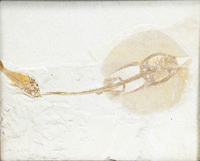 |
Framed 50 Million Year Old Fossil Stingray. Stringrays (Heliobatis radians) are among the rarest and most beautiful of all the Green River, Wyoming fossil fish. These are stingray lived in the fresh water lakes of Green River Wyoming 50 million years ago after being cut off from the late cretaceous inland seas. Stingrays are quite rare in the fossil record because, just like sharks, they are mostly cartilage. This large 17.5 inch stingray is nearly complete from an old time collection and was collected and prepared by Black Hills minerals of South Dakota in the 1960's. The detail is exceptional with the tiny bones of the disc (wings), eyes, three stingers, and even the clasper (one inch long conical shaped organs pointing downward right above the tail) which identifies this stingray as a male being very clear. The tail is defined and present but missing the tiny vertebrae. There is also a 5 inch Diplomystus dentatus fish at the base of the tail of the stingray. This rare museum quality specimen has been backed with plywood and palced in a 18 x 21 x 2 inch wooden frame for hanging.
Add $75.00 for domestic shipping.
Estimated Value $1,500 - 2,000.
View details and enlarged photo
| Realized
$1,495 |
Lot 894 |
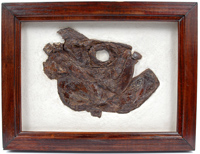 |
Framed 70 Million Year Old Fish Head. Gillicus arcoatus was a large six foot long tarpon-like primitive bony fish that had large scales and microscopic teeth that were not really needed since Gillicus was a filter feeder that ate plankton like modern baleen whales. Gillicus swam the warm inland seas of Western Kansas 70 million years ago and is found in the Niobrara chalk. Gillicus is famous for being found in the stomach of a 18 foot long carnivorous fish, Xiphactinus. Heads and full skeletons are rare with mostly bones from its tail being found adding more evidence of Gillicus being a favorite prey item for Xiphactinus. This complete 8 x 5 inch dark brown skull with two vertebrae and part of its pectoral fin has been expertly mounted in a 13 x 10 inch brown frame ready for hanging.
Add $ 30.00 for domestic shipping.
Estimated Value $800 - 1,000.
View details and enlarged photo
| Realized
$900 |
Lot 895 |
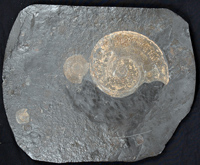 |
Golden Ammonites From Holzmaden, Germany. Holzmaden, Germany is famous for the excellent preserved fossils that are 180 million years old. They are most famous for their golden ammonites. These are ammonites, extinct realtives of octopus and squid, have had their mother pearl shells replaced with golden colored pyrite over the millions of years that they were buried. This large 18 x 17 inch black shale matrix conatins dozens of small ammonites and three larger pyritized ones. The largest pyritized ammonite Hildoceras sp. is 9 inches in diameter and the two smaller Lytoceras sp. are 2.5 and 1.5 inches in diameter. The ammonites show the defining ribbing patterns that indicate the size of the inner chambers. All ammonites from Holzmaden have been flattened under the pressure of fossolization and all desirable in that they can easily be mounted and hung on a wall if desired.
Add $25.00 for domestic shipping.
Estimated Value $400 - 500.
View details and enlarged photo
| Realized
$374 |
Lot 896 |
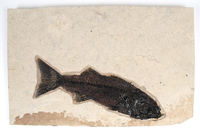 |
Huge 15 Inch Long 50 Million Year Old Trout. Mioplosus labracoides was an extinct relative of modern day trout. It is over 50 million years old from old from the famous Green River Formation near Kemmerer, Wyoming. This enormous 15 inch long fossil is one of the largest found for this species and is virtually complete with excellent detail in the head, body and fins. It is a beautiful dark brown color with detailed small fin bones and even sharp little teeth in both the upper and lower jaws. The 22 x 14 inch limestone matrix has been backed with wood and even has a hook for hanging if so desired. Small fish common from The Green River formation but large fish such as the Mioplosus are in great demand from both collectors and interior decorators for hanging on the wall.
Add $35.00 for domestic shipping.
Estimated Value $500 - 600.
View details and enlarged photo
| Realized
$528 |
Lot 897 |
 |
Huge 97 Million Year Old Guitar Fish. This extremely large 23 x 5 inch long Guitar fish, Rhinobatos hakelensis is 97 million years old from the sublithographic limestone deposits of Haqel, Lebanon. Guitar fish is a ray that is quite primitive and has characteristics of both a shark and a skate. They are bottom feeders with small crushing teeth and feed on crabs and clams. Being cartilaginous they rarely fossilize but this attractive complete brown specimen is the exception. The body, fins, tail, head and dramatic eyes are exquisitely fossilized. The fish is nicely displayed on an 27.5 x 8 inch hard limestone matrix. There has been some repair in putting back together several breaks in the matrix but this is almost always the case for such large slabs of stone as they cannot be taken out of the ground whole and the fossil is not adversely affected by the cracks.
Add $60.00 for domestic shipping.
Estimated Value $1,500 - 2,000.
View details and enlarged photo
| Realized
$1,438 |
Lot 898 |
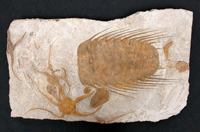 |
Huge Spiny Trilobite And Starfish. At 8 inches this complete well detailed Selenopeltis bucchi trilobite is one of the largest for this species and for spiny trilobites in general. The 3-D detail is phenomenal with small eyes, distinctive body bumps and delicate spines being clear with even small details define. What makes this 14.5 x 8 inch limestone slab so special is the variety of other fossils that are found in their natural positions from their burial in the warm Ordovician seas of Erfoud, Morocco over 475 million years ago. There is a 2 inch long phacops trilobites as well as two very large brittle starfish, the largest being 5.5 inches in diameter and small one 4 inches. There are two strange looking animals called carpoids which were swimming crinoids and are related to starfish. They filter fed from a calyx like a crinoid and had moveable stems for swimming or attaching themselves to the sea bottom. There are two different species present that are 2 inches long. This is an esthetically pleasing natural grouping that illustrate what type of sea creatures were present together in the ancient 475 million year old ocean.
Add $30.00 for domestic shipping.
Estimated Value $700 - 900.
View details and enlarged photo
| Realized
$690 |
Lot 899 |
 |
Huge Starfish AndTrilobite Plate From Morocco. Finding a complete starfish is not easy because the delicate arms break off quite easily during the fossilization process. Finding a mass burial of 45 complete starfish is extraordinary.This huge 33" x 25" museum quality plate is 475 million years old from Lkaidrami, Messeu, South Morocco. This magnificent sea bottom slab preserves a snapshot of what life existed on the sandy bottom of the warm seas of Morocco 475 million years ago. There are 45 brittle stars up to 4 inches in diameter. Brittle starfish usually attach themselves to the sea bottom and filter feed small creatures that float by. Also, there is a large 5.5. inch long spiny trilobite, Selenopeltis which is quite a scare trilobite and very distinctive with its long genal spines that it used for protections. To complete the picture of the Ordovician sea bottom, there is an unusual mystery pair of fossils that could be some sort of sea plant. The larger one is 12 x 3.5 inches and the smaller one is 8 x 4.5 inches. They are bilaterally symmetric with a raised center line all the way up and down their body. Whatever they are they are undescribed. This is a rare opportunity to acquire both a rare and dramatic fossil for both display and study.
Add $100.00 for domestic shipping.
Estimated Value $1,500 - 2,000.
View details and enlarged photo
| Unsold |
Lot 900 |
 |
Huge Three Foot Long 210 Million Year Old Aquatic Reptile. Ichthyosaurs were a fast swimming marine reptile that have been extinct for more than 100 million years and somewhat resembled dolphins in shape. Their bodies were built for speed like a dolphin but their skeleton is very different. The earliest ichthyosaurs were much more reptile-like with longer thinner bodies and smaller fins and paddles. Mixosaurus panzianensis found in the 210 million year old Guaning Formation of Panxian County, China is one of the earliest and the most primitive of ichthyosaurs. It had a long thin body with heavy vertebrae and a straight reptile like tail (not curved like the latest ichthyosaurs). This 39 inch long specimen is more complete than most specimens found with nearly complete vertebrae and tail and with one front and one back paddle. The back paddle is found within the ribcage skull is 8 inches long with more than 20 sharp teeth still present in the jaw and Mixosaurus has a very large 2 x 2 inch eye which may indicate that it swam at somewhat great depths in search of prey. The paddles are just limb bones with many phalanges extending their lenght to created paddles for swimming and steering. This rare and important early ichthyosaur fossil is nicely centered on a 37 x 15 inch black stone matrix that has been backed for stability as the black matrix is somewhat fragile and all the recovered specimens always come out in a number of pieces. There is 10-15 percent restoration on some of the teeth, vertebrae and ribs but overall the specimen is one of the finer fossils available of this rare ichthyosaur.
Add $125.00 for domestic shipping.
Estimated Value $4,000 - 5,000.
View details and enlarged photo
| Realized
$5,750 |
Lot 901 |
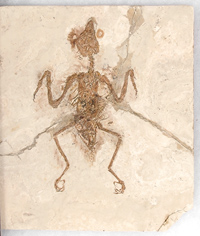 |
Important 135-140 Million Year Old Bird Fossil with Sclerotic Rings and Feathers. This small 5.5 inch long primitive bird, Liaoxiornis delicates was alive in the earliest cretaceous period 135-140 million years ago. The only older bird is Archaeopteryx from Germany at 150 million years old. This nearly complete bird from the Liaoning Province of Northeastern China is quite remarkable in its magnificent preservation. Birds have very delicate light weight bones that are only preserved under very special circumstances such as the rapid burial that occured over 135 million years ago when an enormous volcanic eruption quickly killed an buried in ash this small toothed bird. The preserved detail is truly amazing with small sharp little teeth, delicate rib bones, small hand and feet bones and claws, two sclerotic eye bones and even some features preserved as carbonized impressions around the body and particularly distinct tail features and feathers on one of the legs. The sclerotic rings are rarely preserved and very important in the link between birds and dinosaurs as some dinosaurs also possesed sclerotic rings around their eyes. Sclerotic rings are a ring of bony plates that surrond and protect the eye. This important bird fossil is nicely centerd on a 7 x 6 inch soft tuffaceous stone matrix which has been broken and glued back together as is usually the case as the matrix is very thin and delicate being compressed from volcanic ash. The bird skeleton is hardly effected by the breaks and is enclosed in a 12 x 8 inch riker moutn for display and protection. A much younger and less detailed 50 million year old Green River bird recently sold to a museum for $15,00.00.
Add $50.00 for domestic shipping.
Estimated Value $2,400 - 3,000.
View details and enlarged photo
| Realized
$2,300 |
Lot 902 |
 |
Important and Rare Mounted Skeleton of 30 Million Year Old Mammal, Merycoidon. Merycoidon culbertsoni was a strange early mammal of an extinct group of ruminant known as oreodonts that was only found in North American that had some features like a pig and some features like a camel or deer. Oreodonts are Artiodactyl, which are even toed ungulates. The skull was somewhat pig-like with its enlarged canine teeth but the skull had pits in front of its eyes very similar to a modern deer. While skulls from Merycoidon are found regularly, complete or near complete skeletons are unbelievably rare. This museum quality professionally mounted specimen is 53 inches long with a 7 x 4 inch skull,122631 which is about the average size of an adult Merycoidon. This articulated specimen is completely from one animal and was found in the Brule Formation of Douglas Ranch in Converse County, Wyoming amd is more than 80 percent original bone with the missing elements, mostly some caudal vertebrae and ribs, being expertly cast by a professional paleontoligist. The all important skull is excellent with the most all of its original teeth and is not distored like many found. The mounting is extraordinarily life-like with the supporting rods being put inside the bone and not attached to the outside of the bone. The entire large specimen is supported only by four rods at the base of its legs and all of the legs, skull, body and tail can be easily removed for study and the reattached. Mounted Merycoidon skeletons are missing from most collections whether private or museum. this is a very rare opportunity to purchase an esthetically attractive and important early mammal fossil.
Add $275.00 for domestic shipping.
Estimated Value $10,000 - 13,000.
View details and enlarged photo
| Realized
$10,350 |
Lot 903 |
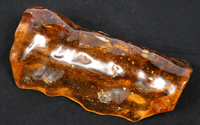 |
Insect In Young Colombian Amber. Amber is the fossilized tree resin. Some trees produce resins to help break and gashes. Occasionally insects become trapped in the sticky amber and are mummified (dessicated) with incredible preservation of soft tissues, muscles, microscopic detail and sometimes even color. DNA has been retrieved from amber over 65 million years old at the time of the dinosaurs. The age amber itself cannot be determined. Only the rock it is deposited in can be tested. Colombian young amber is found mostly in the Andes mountains in remote regions and has not been properly dated. The hardest and the amber with the classic golden honey color like Dominican Amber is probably between 1-5 million years old. Such is the probable age aof this extremely large, 5.25x 2.75 inch clear amber nugget weighing more than half pound (260 grams). The rich color and clarity allow detailed study using a magnifying glass to examine the dozens of fleas, flies, midges, and other small insects. The largest insects is a bee that is 4 inches long. This fossils makes an excellent display and study specimen with many insects having original color and even the tiniest of detail.
Add $10.00 for domestic shipping.
Estimated Value $300 - 350.
View details and enlarged photo
| Realized
$345 |
Lot 904 |
 |
King Tutankamun Style Scarab Made From Libyan Desert
Glass Plus Large Libyan Desert Glass Nugget. When Howard Carter discovered King Tutankhamun's tomb in 1992, one of the precious metal amulets had a scarab carved out of a green colored glass that was clearly special as it was the center stone in the amulet. It turned out to be a piece of Libyan Desert Glass and was dated at 28 million years old. Libyan Desert Glass actually is a tektite of almost pure silica which formed 28 million years ago when a large meteorite exploded over the desert vaporizing itself and a lot of the sand at temperatures in exess of 3000 degrees. The molten sand quickly cooled and fell back to earth in a variety of shapes as pale yellow-green glass. These gemstones were highly valued by the ancient Egyptians and they continue to be so valued today. Libyan Desert Glass is only found in one section of the Great Sand Sea between Libya and Egypt and the likely meteorite crater named Kebira over 19 miles in diameter was found near the Libya-Egypt border. This lot contains a 1.25 inch long Egyptian style scarab similar in the style and size to one in King Tut's amulet plus a very large 3.25 x 2.25 inch 203 gram premium pale green nugget of Libyan Desrt Glass with a meteorite-like surface of craters and scoops. Both specimens are housed in a 8 x 6 inch Riker mount.
Add $15.00 for domestic shipping.
Estimated Value $400 - 500.
View details and enlarged photo
| Realized
$380 |
Lot 905 |
 |
Large Plate Of 275 Million Year Old Early Reptile Tracks. This large 36 x 16 inch plate contains more than a dozen early reptile tracks from the early Permian (275 million years old) on Coconino Sandstone from the Colorado Plateau region near Ashfork, Azinona. These tracks were made from mammal like reptiles like Chelichnus and similar to the tracks of Captorhinus. There are several sized tracks that means that they probably come from several different species of early reptiles. The claws are clearly visible of some of the tracks and the reptile seemed to be walking on its tippy toes in some of the prints. An intersting ichnofossils recreating a moment that occured over 275 million years ago.
Add $35.00 for domestic shipping.
Estimated Value $300 - 400.
View details and enlarged photo
| Unsold |
Lot 906 |
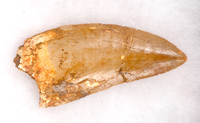 |
Large Theropod Dinosaur Tooth, Carcharodontosaurus. Size does matter in dinosaur teeth. Even though Carcharodontosaurus saharicus was even larger and heavier than a T-Rex, most of the teeth found are only 1.5-2.5 inches long.This unrepaired light brown tooth is 3.5 inches long and has most of its enamel intact with only a few minor chips which are nearly always present. The all important serrations are nearly complete and sharp on both sides of the tooth. It is these steak knife-like serrations that made Carcharodontosaurus such a terrifying predator. This is a shed tooth that were lodt when the dinosaur was feeding on another dinosaur was feeding on another dinosaur and a few teeth would break off when contacting bone. This was not a major problem as dinosaur continually replaced their teeth when needed. Found in the Sahara desert in the Kem Kem region of Morocco, Carcharodontosaurus was older than a T-Rex at 70-80 million years ols. This tooth should be excellent value to any collector desiring a large impressive therepod dinosaur tooth as a T-Rex tooth this size and quality would sell for several thousand dollars. Housed in a 6 x 5 inch Riker mount.
Add $10.00 for domestic shipping.
Estimated Value $400 - 500.
View details and enlarged photo
| Realized
$431 |
Lot 907 |
 |
Massive Museum-Quality Fish Skull From One of the Largest Bony Fish That Ever Lived. The most dangerous seas of all time were certainly the Cretaceous seas that covered the middle part of the United States. These warm, shallow waters were home to many gigantic predators, such as 60-foot-long Mosasaurs, large sharks and Xiphactinus audax. At over 20 feet long, Xiphactinus audax was one of the largest bony fish that ever lived. It was a ferocious predator, with a mouth full of sharp pointed teeth up to 2" long. As a matter of fact, a Xiphactinus audax with a 6 foot fish Gillicus in its stomach is one of the most famous fish fossils in the world, displayed in the Sternberg Museum of Natural History in Hays, Kansas. The gigantic head in this lot is 23" x 22"; its open jaw containing more than 20 sharp, peg-like teeth, the largest front teeth being over 2" long. This exceptionally large skull has been professionally mounted in a plaster matrix simulating limestone and custom framed with a dark brown wood frame measuring 38" x 36". This magnificent 80-85 million-year-old fish fossil found in the Niobrara Chalk of Grove Country, Kansas would be the high-lightof any fossil fish collection.
Add $350.00 for domestic shipping.
Estimated Value $5,000 - 6,000.
View details and enlarged photo
| Unsold |
Lot 908 |
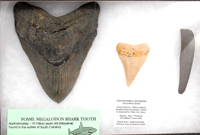 |
Megalodon vs. Great White Shark. Carcharodon megalodon was the largest shark that ever lived growing to more than 50 feet long, perhaps much more. Megalodon ate whales whose vertebrae and teeth are often found along with those of megalodon. This fascinating lot of three fossils has a 3.5 inch long whales tooth that was found along with megalodon teeth under 30 feet of dark water in northern Florida. The main fossil here is a gigantic 6.25 inch long megalodon tooth measured on the diagonal with excellent greenish brown and intact dark brown root. The enamel is well above average with only a few cracks and a few minor chips. The serrations are intact and just a little dull. This is the largest Carcharodon tooth that you can but without paying a fortune for a tooth just .25-.50 inch bigger. This immense tooth is about 15 million years old and was found in the river waters of South Carolina. Just to appreciate how large megalodon was, a rare very large fossilized 2.6 inch Great White Shark's teeth is also included in this lot. This 2-6 million year old complete tooth was found in the English Bay in Chile. Estimating the size of a shark at approximately 10 feet in lenght for every inch of tooth, this White would have been over 26 feet long, but compare it to the megalodon shark whose 6.25 inch long tooth translate to a shark of over 62 feet long. This museum quality shark's teeth and whale tooth collection would certainly create quite an intersting and stunning display.
Add $30.00 for domestic shipping.
Estimated Value $1,000 - 1,300.
View details and enlarged photo
| Realized
$1,093 |
Lot 909 |
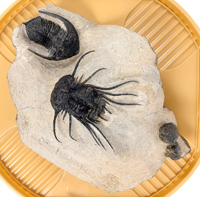 |
Museum Quality Natural Grouping Of Four Trilobites. Trilobites were one of the most successful of all groups of arthropods having survived for more than 250 million years before being wiped out in the Permian extinction. Thus trilobites were extinct before there were even dinosaurs. Trilobites appeared over 500 million years ago and may have been so succesful as they were one of the first animals to have eyes. With over 17,000 described species, trilobites come in all shapes and sizes. This museum quality 7 x 5 limestone matrix contains four trilobites from three different species and shapes. The largest and most unusual is a 3 inch long Dicranurus elegans known as the ram's head trilobite because of its long spines extending backward from its head. What makes this trilobite so spevial is that it is complete and has been carefully prepared in the rock with 3D freestanding rams horns as the long 1.25 inch genal spines. The second trilobite is a Zilchouaspis in a climbing position with excellently detailed compound eyes.
The third and fourth trilobites are phacops with one 1.5 inches partially enrolled with it mouth (hypostome) revealed and the other is 1 inch completely enrolled for protection. A great deal of preparation time has gone into keeping the trilobites in their original position just as they were buried in Alnif, Morocco over 375 million years ago.
Add $30.00 for domestic shipping.
Estimated Value $800 - 900.
View details and enlarged photo
| Realized
$805 |
Lot 910 |
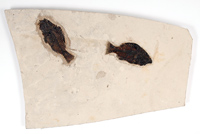 |
Pair of 50 Million Year Old Extinct Bass from Green River, Wyoming. This large 17 x 12 inch limestone slab contains two exquisitely preserved Priscarara sp. fish from the famous Green River Wyoming area. Priscarara was an extinct ancestor of the Bass and is quite distinctive with its thick dorsal and ventral fins. These fish measure 5.5 and 5 inches long and are an attractive dark brown color nicely contrasting the cream colored limestone matrix. The detail is superb with all bones and fins finely detailed. the slab has been backed and is ready for hanging if desired.
Add $25.00 for domestic shipping.
Estimated Value $350 - 450.
View details and enlarged photo
| Unsold |
Lot 911 |
 |
Polished And Etched End Cut Campo Del Cielo Iron-Nickel Meteorite. This large end cut 4 x 2.75 inch over two pound (920 grams) Campo del Cielo iron-nickel meteorite has been cut, polished and etched on two sides to show the interesting Widmanstatten patterns made possible because of the segregation of two nickel compounds Kamacite and Taenite which etch at different levels. This pattern defines these iron-nickel specimens as meteorites because a slow cooling of not more than a few degrees per million years is necessary to allow the nickel alloys to separate. Campo del Cielo meteorites are found in Gran Chaco Gualamba, Argentina about 500 miles northwest of Buenos Aries. Campos are of the category polycrystalline ochahedrite iron nickel meteorites and they are defined by wide in the widmanstatten pattern. End pieces are desirable because they still display the original surface of the meteorite on two sides and the interior structure on the two polished and ecthed ends. This is certainly a large enough specimen to get a good feel for the internal pattern and still possess some original surface with some small regmaglypts (thumbprints).
Add $15.00 for domestic shipping.
Estimated Value $300 - 350.
View details and enlarged photo
| Realized
$230 |
Lot 912 |
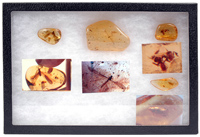 |
Premium Group Of Four Amber Nuggets. This collection of four premium quality clear young amber nuggets from Colombia contains large and dramatic insect in very clear amber nuggets. 1. A big mosquito with a 1 inch wing span in a large 2.75 x 2 inch nugget with several flies and midges. 2. A .8 inch long winged termite plus a fly and other wings in a 1.5 x 1 inch nugget. 3. Two.4inch long stingless bees in a thick 1.25 x 1 inch amber nugget. 4. 5 inch cockroach in a 1.75 x .75 inch amber nugget. The absolute age of young Colombian amber or copal cannot be determined as amber itself cannot be tested and dated, but from the color and hardness of these nuggets, experts suggest their age to be at least 1-5 million years old or older. Each special nugget has a photo of the main insect included and the collection is housed in a 12 x 8 inch riker mount.
Add $10.00 for domestic shipping.
Estimated Value $350 - 400.
View details and enlarged photo
| Unsold |
Lot 913 |
 |
Premium Quality Slab Of Dinosaur Claws And Teeth From The Hell Creek Formation. This 65-70 million year old slab of dinosaur claws, teeth and bones was just cleaned and the largest 4 inch long Ornithomimus claw restored and placed back into its original position as found. Most dinosaur bones and teeth are found in rock that was part of a river or lake bed over 65 million years ago. The fossils are then removed cleansed and restored and sold, but this interesting and educational 12 x 6 inch slab was left intact because they are amany different fossils contained on its ancients river or lake bed surface. There are two huge 4 inch and 3 inch Ornithominus hand and foot claws, a 1.25 mostly complete Nanotyrannosaurus tooth with good serrations, some Champosaur teeth, crocodile teeth and scutes, pieces of dinosaur bone and other intersting fossils to study. Ornithomimus was fairly large ostrich like dinosaur without teeth but with long sharp claws such as the 4 inch hand claw found on this slab. There is also a inch long foot claw also belonging to Ornithomimus.The huge hand claw was removed from the matrix, cracks filled and perhaps some restoration to the tip and put back in a place in a 3D elevated position on the sandstone matrix. The important 1.25 inch Nanotyrannous tooth is a virtually complete shed tooth. There are many other fossils to be identified on this excellent study and display fossil from te Hell Creek Formayion of South Dakota.
Add $35.00 for domestic shipping.
Estimated Value $1,300 - 1,600.
View details and enlarged photo
| Realized
$1,438 |
Lot 914 |
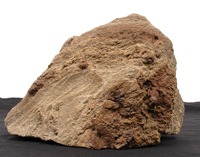 |
Rare Dinosaur Skin With Soft Tissue. Dinosaur skin is the rarest and most coveted of dinosaur fossils because of its extreme rarity being preserved only under extraordinary conditions. The dinosaur had to have been completely covered by fine mud sediments probably in a large river delta within a day or so after to avoid bacterial breakdown of the skin and soft tissue which would occur immediately. This type of extreme condition may have occured in a massive flood. The skin texture was impressed in detail in the soft clay forming a natural mold which was later filled by more muddy sand creating a antural cast and remained intact for over 65 million years even after skin and other soft tissue was destroyed by bacteria. This large section of dinosaur skin is from an Edmontonsaurus duckbilled dinosaur is between 65-70 million years old and was found along with some fragmented Edmontonsaurus bones in the Hell Creek Formation of Montana.
This very large slab containing both dinosaur skin impressions plus some soft tissue preservation is 11 x 9 7 inches. One of the edges has a large very distinct skin impression measuring 7 x 3 inches plus on one of the 11 inch sides there is a well detailed long section of skin measuring 12 x 1.25 inches that curves back inside the matrix where there is almost certainly more skin to be found. On the opposite long 11 inch side from this can be found the unbelievably rare fossilization of soft tissue. Of particular interest is a 5 x 4 inch section that has some small and larger brown bumps and some dark brown harder stuctures that almost look like bone except there is absolutely no porous bone structure that would certainly be preserved on this well preserved specimen if they were bone. They are traces of soft tissue in the dinosaur that was preserved underneath the skin layer. What they are needs to be determined as its is quite possible that these structures have never been observed before in a dinosaur. Most sections of dinosaur skin offered for sale are quite small due to the high value of dinosaur skin impressions, but this unique piece of dinosaur skin and soft tissue fossilization has been left intact for both museum quality display and study.
Add $50.00 for domestic shipping.
Estimated Value $3,000 - 4,000.
View details and enlarged photo
| Realized
$2,645 |
Lot 915 |
 |
Rare Permian Age Primitive Reptile. Captorhinus aguti was one of the very first reptiles that laid its eggs on dry land (amniote) and was an early ancestor of synapsids and other reptiles. It known as a stem reptile and other reptiles and mammal like reptiles branched off from it. Eventually, one of these branches evolved into the Archosaurs that survived the Permian extinction and gave rise to the dinosaurs much later. This impressive looking mounted specimen is a composite as are all of the mounted Captorhinus skeletons. The bones are carefully cleaned, matched and assembled to yield an impressive specimen such as this 12.5 inch long museum quality specimen having only about 15 percent restoration mostly on the ribs and some cracks in the skull. The 270 million year old bones are found in a quarry in the Arroyo formation near Lawton, Oklahoma and represent a catastrophe that killed hundreds of these reptiles at one time. Much work was done to carefully clean, size and mount such a complete specimen as this. The detail is excellent particulary the skull which has been prepared open to show the rows of tiny sharp teeth and also the mysterius small round hole in the center of the skull which paleontologist speculate may have allowed sunlightto enter the skull to the pineal gland. Another feature of the preparation is that the ribs have been cemented to the matrix adding stability to the very delicate bones and still keeping a very natural appearance that the large reptile is crawling over the matrix.
Add $75.00 for domestic shipping.
Estimated Value $2,500 - 3,000.
View details and enlarged photo
| Realized
$2,300 |
Lot 916 |
 |
Scarce Bottom Feeding Sand Fish From Green River Formation. Notogoneus osculus was rarely found 50 million year old bottom feeding sand fish from the famous Green River Formation Wyoming. This complete specimen is quite large being 15.5 inches long backed on a 21 x 19.5 inch limestone matrix. Notogoneus had a down turned mouth and fed on small animals crawling on or buried in the sandy lake bottom such as crabs, worms etc. The body is a chocolate brown color with a 3 inch long black skull nicely detailed against the cream colored sandstone matrix.There is outstanding body and fin detail that the 18 inch layer near Kemmerer, Wyoming is famous for 50 million years ago this area was much different than it is today being subtropical to moderate with these fish being beautifully fossilized when the large fresh water lakes evaporated when the conditions became much more arid. This impressive and scarce fish has been backed and is ready for hanging if so desired.
Add $75.00 for domestic shipping.
Estimated Value $900 - 1,000.
View details and enlarged photo
| Unsold |
Lot 917 |
 |
Set Of The Four Major Shapes of Indochinites Tektites. Tektites are glass-like objects that formed when a very large meteorite impacted the earth vaporizing itself and melting earth rocks to over 2000 degrees F. The meteorite was mostly likely a part of a stony asteroid or part of a comet as it was completely vaporized in an enormous high in earth's atmosphere. Unlike meteorites, Tektites are only found in certain parts of the world sometimes near a meteorite crater and sometimes not. The black Indochinites are found mostly in and around Thailand and are a glossy black color made up of mostly amorphous silica somewhat resembling odsidian. They have been dated to be about 800,000 years old which be the date of the impact when they formed out of the molten earth and meteorite. The impact crater has not been located but might possibly be somewhere in the Gulf of Tonkin. The tektites get their shape depending on the speed of rotation of the molten rock as it quickly cools after being ejected high into the earth's atmosphere. As the molten rock solidifies into small objects, if there is no rotation it will form a sphere, a slow rotation will form a flattened disc, fast roation will form a rod or dumbell shape and fast rotation will form a teardrop shape.
This lot contains four sizeable specimens of each of the four shapes. 1. a 2 x 2 inch sphere weighing 109 grams. 2. a 3 x 2.5 inch flattened disc weighing 138 grams. 3. a 4 x 1.25 inch dumbbell weighing 121 grams and 4. a 3 x 1 inch teardrop weighing 52 grams. These specimen are larger than most found tektites and have excellent character with craters and pits that occured when air escaped as they quickly cooled in the atmosphere. Contained in a 8 x 6 inch Riker mount.
Add $15.00 for domestic shipping.
Estimated Value $300 - 350.
View details and enlarged photo
| Realized
$219 |
Lot 918 |
 |
Spectacular Museum Quality Shovel Nose Spiny Trilobite. One of the most spectacular spiny trilobites is this 5.25 inch long 375 million year old Psychopyge from Alnif, Morocco. Not only did it have short and long spines covering all of its body, but is also had a 1.5 inch long shovel in front of its head that was probably used to dig in the ocean bottom to find prey and possibly to hide from predators. This large impressive trilobite has been professionally prepared to reveal even the most intricate details such as the very long 2 inch spines from the back of the head being free standing away from the matrix, the curious curved spine on the top of its head, all of the small sharp spines lining its body down the center and on both sides and all of the facets on its copound eyes. This is not average qaulity prepared trilobites, but is a museum quality specimen that would one of the highlights of any trilobite colletion.
Add $35.00 for domestic shipping.
Estimated Value $700 - 900.
View details and enlarged photo
| Realized
$748 |
Lot 919 |
 |
Three Egg Unhatched Hadrosaur Dinosaur Egg Nest. The three eggs in this partial dinosaur nest are still the same position on the red limestone matrix where they were deposited by the mother duckbill dinosaur 70-80million years ago in the Henan Province of China. What makes this nest exceptional is the quality of the eggs, each egg has between 80-99 percent of its original shell and has had the rock layer professionally removed leaving the original shell in a dark grey color. The eggs are slightly compressed from being buried under tons of rock but show only minimum cracking with the best egg having close to 100% original shell and the other two eggs 80-90 percent original shell. The eggs are as large as Duckbill dinosaur eggs get being 6.5 x 6 inches and are lined up in a 17 x 6.5 inch red sandstone matrix. We cannot be sure what species of Duckbill (hadrosaur) dinosaur laid thesse eggs because these oval eggs come in different diameters and no embryos have ever been found in eggs of this shape in China. However, in the U. S. eggs of this shape have been found that do contain embryos that have been identifies as being Duckbill dinosaurs. All dinosaur eggs are becoming more difficult to locate and premium quality professionally prepped original eggs such as those found in this nest are in great demand.
Add $75 for shipping domestic.
Estimated Value $1,500 - 2,000.
View details and enlarged photo
| Realized
$1,380 |
Lot 920 |
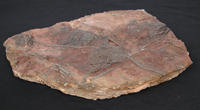 |
Three Large Floating Crinoids. Found in Erfoud, Morocco, this large 16 x 9 inch slab contains three near complete large Scyphocrinites crown with exquisite delicate detail and quite large being 3 x 3, 3 x 2 and 2 x 2 inches. These dark brown crinoids even still have some of their stems attached to the crowns. Close examination reveals the detailed feather-like feeding arms and small star-shapped calcite plates. There are two other partial crowns and several sections of additional stems Crinoids are related to star fish and are known as "sea lilies' because they resemble plants more than animals. Scyphocrinites were an interesting floating crinoid with its stem attached to a roundair-filled bulb that floated on the surface of the ocean. When the crinoids died, they would separate from their flotation bulbs and settke on the ocean bottom and the stemd would quickly break apart. This esthetic grouping of 475 million year old crinoids would make a fine addition to any fossil collection.
Add $25.00 for domestic shipping.
Estimated Value $400 - 575.
View details and enlarged photo
| Unsold |
Lot 921 |
 |
Two Different Fossil Feathers And Bird Footprints. Green River, Wyoming is well known for its well preserved fossil fish, but there are other much rare fossils to be found in these 50 million year old lakebeds of a long since dried up fresh water lake. Fossil birds are extremely rare and very expensive when encountered, but this lot consists of three bird fossils. 1. A 7.5 x 5 plate inch plate containing 6 complete bird footprints that were made in the muddy shore 50 million years ago. Each footprint is 1 inch in diameter and nice dark brown color. 2. A. 9 long asymmetric flight feather from an unidentified shore bird with a well detailed vane that is formed from a series of small barbs interlocked together. The barbs are asymmetrically arranged on either side of the shaft to give the bird an aerodynamically desirable shape to produce lift when flying. 3. A large 2 inch long symmetric contour body feather that is nearly complete but not as detailed as the other feather. This collection of scarcer Green River fossil found near Kemmerer, Wyoming is housed in a 12 x 8 inch Riker mount.
Add $15.00 for domestic shipping.
Estimated Value $300 - 400.
View details and enlarged photo
| Realized
$230 |
Lot 922 |
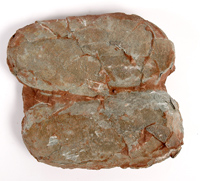 |
Two Museum Quality Oviraptor Dinosaur Eggs From China. Oviraptor dinosaur eggs are in high demand for their rarity and because of the amazing discovery of and adult Oviraptor skeleton sitting on top of nest of eggs such as the pair offered here. Initially, Overaptor (meaning egg stealer) was thought to be a predatory dinosaur who ate these eggs but this was found to be incorrect with the 1995 discovery in Mongolia.
This pair museum quality Oviraptor eggs are 6 inches long x3 inches wide and are a light tan color still sitting on part of the original reddish-brown stoenmatrix as found in the Nanxiang basin, Guabdong Province of China and are about 70 million years old. Both eggs have more than 90 percent of their original shell and maintain their distinctive oblong shape with only slight crushing. Most recoverd Oviraptor eggs are missing much of their original shell because the shell thickness is thin and lost. Also, both of these eggs have the raised dimple-like raptor shell pattern inpristine condition. With the supply of dinosaur eggs becoming quite limited. It is a rare opportunity to acquire such top quality Oviraptor eggs.
Add $40.00 for domestic shipping.
Estimated Value $1,300 - 1,750.
View details and enlarged photo
| Realized
$1,265 |
Lot 923 |
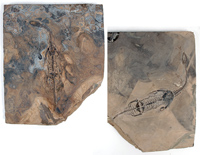 |
Unusual Pair of 240 Million Year Old Mini Guizhou Dragons, Marine Reptiles. Better known as Keichousaurus, these mini dragon have been collected and highly valued for good luck by Chinese for hundreds of years.This 10 x 8 inch slab has not one but two large specimens, one on each side of side of the slab. The largest and better preserved specimen is 9 inches long virtually complete with only a couple of the tiny digits and claws of feet and very tip of the tail missing. The ribs, tail, tiny foot bones and in partiicular a good skull are black in color sitting on a 10 x 8 inch lighter brwon matrix. The second Keichousaurus on the back of the matrix is 8.5 inches long and also above average although the skull is not as detailed and there are few more missing foot digits and claws. Keichousaurus, an early ancestor to the long necked Plesiosaur, also gave birth to live young rather than returning to dry land to lay eggs. This is a very dramatic specimen with two fossils on either side of the same matrix.
Add $25.00 for domestic shipping.
Estimated Value $600 - 800.
View details and enlarged photo
| Realized
$661 |
Lot 924 |
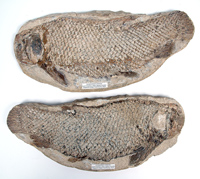 |
Wonderfully Preserved Foot Long Extinct Gar Fish. This lot contains both the positive and negative parts of a virtually complete specimen of an extinct member of the gar fish family. Araripelelidotes temnurus (Lepidotes). The 100-110 million year old fish is complete except for some detailed parts of the skull and the very end of the tail fins but is one on the best preserved snd complete fish to be found from the Santana Formation, Chapada do Araripe,Ceara Province of Brazil. It is 12 x 5 inches still positioned on its limestone matrix. The thick enamel scales that covered its body are well preserved on both the positive and negative slabs. The pectoral, dorsal and tail fins are also well preserved. This is a rare fish from this formation and the preservation is extrordinary. Lepidotes had peg-like teeth and ate mollusks by crushing their shells with the peg-like teeth. 100-110 million years ago northeastern Brazil was covered by a shallow inland sea and South America had just started to drift apart from Africa. This fossil is missing from most fish collections.
Add $40.00 for domestic shipping.
Estimated Value $800 - 900.
View details and enlarged photo
| Unsold |
Lot 925 |
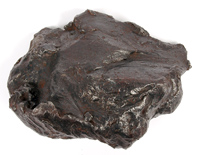 |
Extremely Large Over Eight Pound Sikhote-Alin Iron-Nickle Meteorite. This Extremely Large 6.5 x 4.5 x 1.75 Inch 8.42 pound Silhote -Alin Iron Nickel meteorite is a very attractive and most interesting example of a shrapnel type Sikhote-Alin meteorit. It shows many features of the huge explosion that took place on Feb 10, 1947 high above the Sikhote-Alin mountains of Siberia. The enormous explosion tore the meteorite into thousands of smaller pieces and knocked people off their feet several miles away from the blast. There were at least two different explosions of the meteorite. The first explosion was much higher up in the atmospher and the meteorites from this initial explosion exhibit regmaglypts (thumbprints) from melting for a longer time in the earth's atmosphere. The second explosion occured much closer to the ground and these meteorites show the ripping force of the explosion resulting in sharp edges and there was not enough time to from the regmaglypts. This large 8.42 pound meteorite shows many signs of the explosive shearing forces as well as many flow lines where the metal was melting at the high temperatures in the atmosphere. These metal flow lines go in a number of different directions on the meteorite indicating that the meteorite was tumbling through the atmosphere when it hit the ground. The freshness of the Sihote-Alin meteorites make them the most popular of the iron-nickel meteorites with outstanding surface detail such as these flow lines that has rusted off the older iron-nickel meteorite falls. Also, the size of this meteorite is unusual in the most Sikhote-Alin meteorites found are much less than a pound in weight with the average specimen weighing only a couple of ounces.
Add $20.00 for domestic shipping.
Estimated Value $1,500 - 2,000.
View details and enlarged photo
| Realized
$1,898 |
|
|